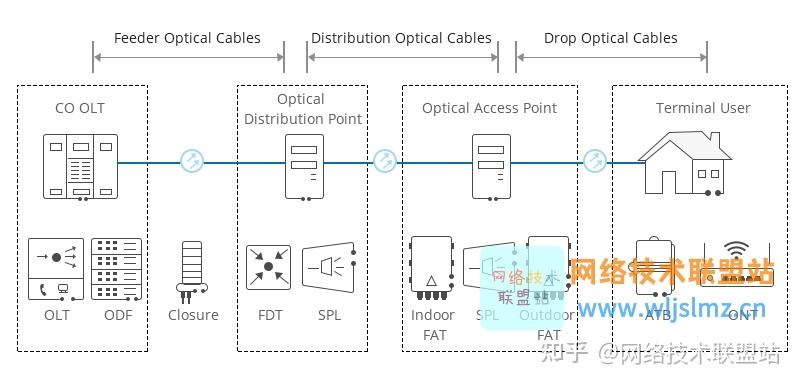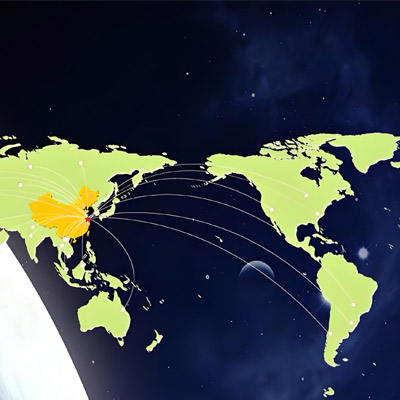Detailed explanation of the basics of PON: OLT, ONU, ONT and ODN, Bai-link Communications
Fiber to the Home (FTTH) has begun to attract the attention of global telecommunications companies, and technology has developed rapidly. Active optical networks (AON) and passive optical networks (PON) are the two major systems that make FTTH broadband connections that can provide cost-effective solutions. PONs are more common in most FTTH deployments.
This article will introduce the basic knowledge of PON, mainly involving basic components such as OLT, ONT, ONU, and ODN and related technologies.
Detailed explanation of PON: Definitions, Standards and Advantages
A passive optical network refers to an optical fiber network that uses a point-to-multipoint topology and optical splitters to transmit data from a single transmission point to multiple user endpoints. Compared to AON, multiple customers connect to a single transceiver through a fiber branch tree and a passive splitter/combiner unit, operating entirely in the optical domain, with no power supply in the PON architecture.
There are currently two main PON standards: Gigabit Passive Optical Network (GPON) and Ethernet Passive Optical Network (EPON).
Their topologies are basically the same. As the first choice for many FTTH deployment scenarios, the PON solution has several outstanding advantages:
lower power consumption
Requires less space
higher bandwidth
a higher level of security
Easier to install and expand
Reduce operating and management costs
PON structure and components
In Gigabit Ethernet passive optical network (GEEPON) systems, the service provider's central office has an optical line terminal (OLT), and there are multiple optical network units (ONUs) or optical network terminals (ONTs) near the end user that act as optical splitters (SPL). In addition, transmission between OLT and ONUs/ONTs also uses ODN (Optical Distribution Network).
Optical Line Terminal (OLT)
The OLT is the starting point of the passive optical network and is connected to the core switch through Ethernet cables.
The main functions of the OLT are to convert, frame and transmit signals for the PON network, and coordinate multiplexing of optical network terminals to share upstream transmission.
OLT equipment generally includes a rack, CSM (Control and Switch Module), ELM (EPON Link Module), redundant protection-48V DC power supply module or a 110/220V AC power supply module, and fans.
Among these parts, the PON card and power supply support hot plugging, while another module is built in. The OLT has two floating directions: upstream (distributing different types of data and voice traffic from users) and downstream (obtaining data, voice,
Optical Network Unit (ONU)/Optical Network Terminal (ONT)
ONUs convert optical signals transmitted through optical fibers into electrical signals. These electrical signals are then sent to individual subscribers.
Typically, there is a distance or other access network between the ONUs and the end user's residence, and in addition, the ONUs can send, aggregate and organize different types of data from customers and send it up to the OLT.
Collation is the process of optimizing and reorganizing data streams for more efficient delivery. The OLT supports bandwidth allocation that allows smooth floating transmission of data to the OLT, which typically arrives in bursts from customers. ONUs can connect via a variety of methods and cable types, such as twisted copper pair, coaxial cable, optical fiber, or via Wi-Fi.
End-user equipment can also be called an optical network terminal (ONT). In fact, ONT is essentially the same as ONU. ONT is an ITU-T term, while ONU is an IEEE term and belongs to different standard bodies, both refer to user-side equipment in the GEPN system, but in practice, ONT and ONU are slightly different based on their location.

Optical Distribution Network (ODN)
ODN is an integral part of the PON system and provides an optical transmission medium for the physical connection of ONUs to OLT at distances of 20 kilometers or more.
Within the ODN, optical cables, optical fiber connectors, passive optical splitters and auxiliary components work together.
ODN is specifically divided into five sections: feeder optical fiber, optical distribution point, distribution optical fiber, optical access point and incoming optical fiber.
The feeder optical fiber starts from the optical distribution frame (ODF) in the central office telecommunications room and ends at the optical distribution point for long-distance coverage.
The distribution optical fiber from the optical distribution point to the optical access point allocates optical fibers to the area next to it, and the optical fiber is introduced to connect the optical access point to the terminal (ONT), realizing optical fiber to the home. In addition, ODN is an indispensable path for PON data transmission, and its quality directly affects the performance, reliability and scalability of the PON system.

Conclusion
OLT, ONU or ONT, ODN are the main components of the GEEPON system and are currently widely used in FTTH applications. Reduced wiring infrastructure (no active components) and flexible media transmission help make passive optical networks more suitable for home Internet, voice and video applications. In addition, passive optical networks can also be applied to university campuses and business environments, providing cost-effective solutions, and as PON technology continues to advance, its potential applications continue to expand.











